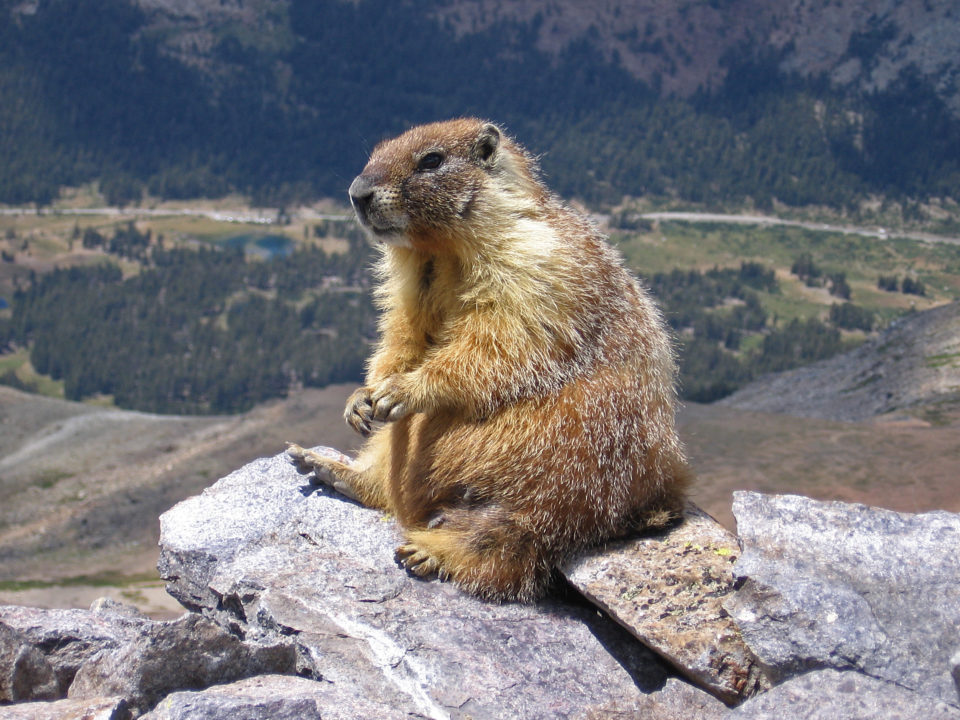Hannah Fake
Many of the familiar animals that inhabit the Sawtooth Mountains and valleys are still around, but you are unlikely see any of them during the winter. Long cold days and very few food sources mean many of our Sawtooth critters migrate or hibernate. Most creatures who have not left for warmer climates will be hibernating through the area’s coldest months. This post is the second in a series of three looking at where our Sawtooth animals are now.
There are a few different ways that animals sleep through the cold. Hibernation is the most common term used. Hibernation is a form of torpor. Torpor is when metabolism drops to less than five percent of normal. Almost all physiological functions are slowed or halted; body temperature drops, breathing slows, heart rate slows, and the brain has very little activity. Many animals go into torpor to avoid heat or cold. Hibernation is a long form of torpor. Animals that hibernate do periodically wake up to warm up and pass waste; this is where most of their energy is spent. Marmots and black bears are two of the Sawtooth’s hibernators.
Black bears pass the winter in dens, under logs, in caves they dig, or in rocky crevices. It is debated whether bears are true hibernators because they tend to wake up far less often than other hibernators. The consensus is that bears are just highly efficient hibernators and hibernate differently than most other hibernating animals, mainly rodents. Bears can go 100 days without waking, needing to eat, or pass any waste and they are more easy to wake up from hibernation. Bears also do not lower their body temperature as much as other hibernators.

Prior to hibernation the bears of the Sawtooths will be out in the valleys gorging themselves on berries, mushrooms, insects, and occasionally other animals or carrion, eating up to 20,000 calories in a day. By late Fall they will have built up four or five inches of body fat and grown a much thicker coat for insulation. During hibernation bears will use about 4 thousand calories a day, mostly to keep themselves warm. Mothers will give birth to young during the long winter months sometimes not even waking from hibernation. The cubs snuggle close for warmth, find her milk, and begin to grow. In the spring the mother will only emerge when her cubs are big enough to follow her around.

One of the Sawtooth’s other hibernators is the marmot. These chubby creatures can be found in mountain meadows near outcroppings of rocks, where they feed and sun themselves. As the weather turns cold marmots head to special hibernation chambers dug deep underground, well below the frost line, where they spend the winter. These burrows can be five to seven meters deep. They too have stored up on fat from grazing the grasses, flowers, and seeds in the meadows above where they are now sleeping. Marmots hibernate together; sometimes just two individuals but up to as many as twenty individuals. A few individuals may hibernate alone if they do not belong to a social group but this makes the winter a lot harder to survive.
Marmots will spend over half their lives in hibernation and 80% of their lives underground. It’s no wonder they are always trying to sun themselves when the weather is good! When marmots go into torpor, to hibernate, they lower their body temperature to as low as 41 degrees Fahrenheit and lower their heart rate to 30 beats per minute. Their respiratory rate also slows greatly. All these physiological traits help the marmots conserve energy. When marmots are deep in hibernation they will only rouse themselves to pass waste and warm up their body temperature a bit about every two weeks. As spring approaches this will happen more frequently.
Most other Sawtooth rodents hibernate for the winter as well. Other ground squirrels, like the Columbian ground squirrel, or the golden-mantled ground squirrel, will be hibernating deep underground through the long winter months relying on stored fat and each other’s warmth.
Although hibernation may seem like an easy way to pass the winter, sleeping away in a cozy burrow, it can come with a cost. Many animals, usually smaller rodents, and the year’s young often don’t survive the winter if they can’t store enough fat. Warming temperatures throughout the winter mean animals are waking up more often, and earlier, before any food sources are available. This means they waste precious energy as they move about and wake up with increasing frequency. However, snoozing away the snowy season is successful strategy for many of our Sawtooth species.
Although we may not see out bears, marmots, and other hibernators, they are still here in the Sawtooths. Curled up asleep in dens and burrows, they are passing the coldest months in a deep sleep. As the flowers bloom and the snow recedes each spring we will also start to glimpse our hibernators again. They too are excited for warmer days and finally some food!
Hannah Fake was the Lead Naturalist for the Sawtooth Interpretive and Historical Association for two seasons and now works for the Forest Service in the SNRA. She spends almost all her free time roaming the mountains and valleys on the lookout for any local wildlife.
Sources:
https://www.nationalgeographic.com/news/2017/10/animals-hibernation-science-nature-biology-sleep/
https://www.denali.org/denalis-natural-history/black-bear-hibernation/ https://bear.org/do-black-bears-hibernate/#:~:text=Short%20answer%3A%20yes.,bears%20were%20not%20considered%20hibernators.&text=They%20lower%20body%20temperature%20to,food%2C%20and%20eliminate%20body%20wastes.
https://thealpinemarmotproject.org/learn-more-about-marmots/hibernation/
http://naturemappingfoundation.org/natmap/facts/yellow-bellied_marmot_712.html